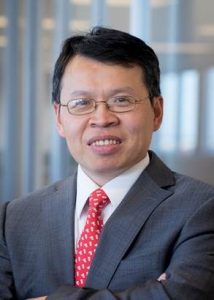Upcoming Webinar on A Revolutionary Multiscale Approach to Bridging Materials Genome and Structural Analysis for Composites
Don’t miss the upcoming NAFEMS webinar on multiscale modeling of composites by Dr. Wenbin Yu, CTO of AnalySwift and Associate Professor in the School of Aeronautics and Astronautics at Purdue University. The presentation, “Structure Genome: A Revolutionary Multiscale Approach to Bridging Materials Genome and Structural Analysis,” will be held Tuesday, February 28, 2017, at 11:00 a.m. EST (8:00 a.m. PST). The Mechanics of Structure Genome theory underlies AnalySwift’s powerful SwiftComp composites modeling software. Please register today.
Below is an overview from the NAFEMS website landing page for the webinar.
Materials Genome Initiative (MGI) aims to deliver the required infrastructure and training to accelerate discovery, developing, manufacturing, and deploying of advanced materials in a more expeditious and economical way. However, material by definition is a matter from which a thing can be made of. Ultimately speaking, it is not the material performance, but the structural performance or rather system performance we are after. Thus, materials genome must integrate with structural analysis to maximize the benefits of accelerated development of advanced structural materials.
To fill the gap between materials genome and composite structural analysis, a new concept, Structure Genome (SG) is proposed. SG acts as the basic building block connecting materials and structures and contains all the constitutive information needed for a structure the same fashion as the genome contains all the intrinsic information for an organism’s growth and development. The Mechanics of Structure Genome (MSG) represents a revolutionary approach to multiscale modeling drastically different from the conventional bottom-up multiscale modeling approaches. The principle of minimum information loss (PMIL) is used to avoid a priori assumptions commonly invoked in other approaches and decouples the original problem into two sets of analyses: a constitutive modeling and a structural analysis. The structural analysis can be routinely performed in commercial FEA software. MSG confines all approximations to the constitutive modeling which can construct constitutive models for all types of structures including 3D solids, 2D plates/shells, and 1D beams, directly linking the structural properties with microstructural details. When specialized to 3D structures, this approach provides a general-purpose micromechanics theory which can provide a better alternative to the RVE analysis and asymptotic homogenization theory in terms of efficiency, accuracy, and versatility. MSG provides a unified treatment for all microstructures (periodic, aperiodic, partially periodic). With MSG, multiscale constitutive modelling is simplified to answer three fundamental questions: 1) what is the original model needed for capturing relevant physics? 2) what is the model wanted for a particular design? 3) what is the SG? With answers of these three questions, MSG allows one to choose the starting scale and ending scale and capture details as needed and affordable.
About the presenter
 Dr. Wenbin Yu is an Associate Professor in the School of Aeronautics and Astronautics at Purdue University. He received his PhD in aerospace engineering from Georgia Tech and MS in engineering mechanics from Tsinghua University, China. He serves as the Director for Composites Virtual Factory HUB and as the Associate Director for Composites Design and Manufacturing HUB, and the CTO for AnalySwift LLC. His expertise is in micromechanics and structural mechanics with applications to composite/smart materials. He has developed several computer codes which are being used in government labs, universities, research institutes and companies. He is an ASME Fellow and AIAA Associate Fellow. He serves on the editorial boards of two international journals: The Scientific Pages of Aerospace Engineering and Mechanics and Advances in Aircraft and Spacecraft Science. He served as chair for ASME Structures and Materials Technical Committee and currently serves as vice chair for AIAA Materials Technical Committee.
Dr. Wenbin Yu is an Associate Professor in the School of Aeronautics and Astronautics at Purdue University. He received his PhD in aerospace engineering from Georgia Tech and MS in engineering mechanics from Tsinghua University, China. He serves as the Director for Composites Virtual Factory HUB and as the Associate Director for Composites Design and Manufacturing HUB, and the CTO for AnalySwift LLC. His expertise is in micromechanics and structural mechanics with applications to composite/smart materials. He has developed several computer codes which are being used in government labs, universities, research institutes and companies. He is an ASME Fellow and AIAA Associate Fellow. He serves on the editorial boards of two international journals: The Scientific Pages of Aerospace Engineering and Mechanics and Advances in Aircraft and Spacecraft Science. He served as chair for ASME Structures and Materials Technical Committee and currently serves as vice chair for AIAA Materials Technical Committee.











